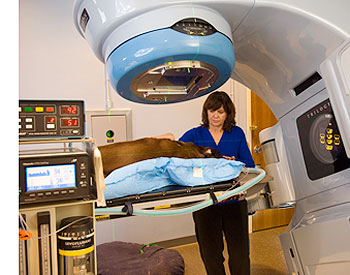Nearly every dog gets a little lumpier as he gets older. Most of these masses are just a benign part of the skin’s aging process, but among the fatty tumors and cysts lurk some dangerous cancers.
So how do we find the wolf hiding in sheep’s clothing, so to speak?
You are the first line of defense against cancerous tumors on your dog. Give full-body massages as often as you can, to familiarize yourself with the topography of your dog’s skin. If you want to be an A+ student, measure lumps and keep a monthly journal of them. When you go to the veterinarian for your annual exams, be sure to point out all of the irregularities you have noticed. Between visits, if you notice new or growing masses, make an appointment to have it looked at sooner rather than later.
What kinds of tests will my vet want to run?
If it is bigger than the size of a pea, it can usually be sampled simply by extracting cells with a needle and syringe (the same one used for vaccines). Your veterinarian will look at these cells to determine whether or not they look cancerous. This is called a fine needle aspirate and cytology. If this procedure does not give us enough information, we may take a slightly larger piece of tissue called a biopsy. This can often be done under light sedation or by just numbing up the area.
Why not just take the tumor off?
Without knowing what we are removing, there is the chance we could miss microscopic pieces of it in the surrounding skin, which will require an additional surgery. Furthermore, in some cases, leaving these cells behind can actually cause the tumor to behave more aggressively. In fact, studies have shown that the best chance for curing a skin tumor is by removing it effectively the first time around. Knowing what we are getting into helps us plan for surgery to provide the optimal outcome.
But what if it just looks like a fatty mass?
Nine times out of ten, if it looks like a fatty mass, it is. But in that tenth case, we are missing a potentially curable cancer. When the procedure to detect this cancer carries zero risk and minimal cost, why take the chance? We could be talking about adding years to your dog’s life, here.
What other options are there besides surgery?
Most of the time, surgical removal is the treatment of choice, however there are other options. Radiation therapy, which involves directing x-ray beams at the tumor to kill cancer cells on a microscopic level, is a procedure only done at large specialty practices and universities, but it provides another viable option when surgery isn’t possible or isn’t enough. Chemotherapy is not commonly used as the primary treatment for skin tumors, but can often help slow or eliminate metastasis, or spread to other parts of the body.

So next time you are visiting your veterinarian, be sure to have a thorough discussion about making sure you know what all of your dog’s lumps and bumps are. And for more information, be sure to check out this YouTube video about the “Don’t Wait, Aspirate!” campaign to reduce fatal skin cancers in dogs.





